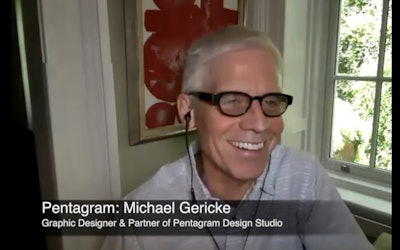Michael Gericke is a graphic designer and a partner at Pentagram’s New York office. He has played a pivotal role in shaping the visual language of many iconic brands, cultural institutions, and public spaces.
Known for his influential work in identity design, branding, and environmental graphics, his projects are recognized for their elegant simplicity and clarity—often capturing the essential qualities of the object or topic he is representing.
His work is widely seen and has become a recognizable part of daily culture.
Michael’s contributions to graphic arts, storytelling, and placemaking are significant, making him one of the leading figures in the development of experiential design. He has received numerous accolades from both design and civic institutions. His work appears regularly in international exhibitions and is part of the permanent collections of many museums around the world as examples of exemplary design.
He is the author of Graphic Life, a bestselling book on design, identity, storytelling, and the built environment.
Among his many visual and brand identities are One Laptop Per Child—an initiative with MIT that provides low-cost computers to underprivileged children around the world—Public Radio International (PRI), Rockefeller Center, and the AirTrain systems that connect Manhattan to Newark and JFK International Airports.
His branding work also spans the world’s largest sporting event, the FIFA World Cup; the logo for the Big 10 intercollegiate athletic conference; the environmental graphics and signage for the Arizona Cardinals NFL stadium; and CBS’s television coverage of the Winter Olympic Games.
Michael’s cultural projects include the Smithsonian’s Cooper Hewitt National Design Museum, Washington, D.C.’s National Gallery of Art, and the Guggenheim’s new museum in Abu Dhabi.
His educational work includes the identity and orientation system for MIT’s sprawling Cambridge, Massachusetts campus and Cornell University’s new Cornell Tech district on Manhattan’s Roosevelt Island. Michael and his team created the graphic program for P.S. 62—New York City’s inaugural net-zero-energy school, one of the first in the United States—designed to generate as much energy as it consumes.
His public realm work is far-reaching. He has contributed to the redevelopment of New York City’s Moynihan Station, Hudson Yards, and One Vanderbilt, Midtown Manhattan’s tallest office tower. His iconic international projects include Mumbai’s and Toronto’s international airports, and the Marina Bay Sands integrated resort on Singapore’s inner harbor.
For decades, he has played a significant role in the design efforts to rebuild the World Trade Center site following September 11. His designs include graphic programs for One World Trade Center—the tallest building in the Western Hemisphere, by Skidmore, Owings & Merrill—as well as Towers Two, Three, Four, and Seven, and the PATH intermodal terminal designed by Santiago Calatrava.
Michael was named a Fellow of the Society for Experiential Graphic Design for promoting the highest values in identity and experiential design and for significantly contributing to the direction and growth of the field. He is the recipient of the American Institute of Architects’ Harry B. Rutkins Award for his outstanding design and contributions to the profession.
He received the Distinguished Alumni Award for his professional and civic achievements from his alma mater, the University of Wisconsin, and was elected a member of Alliance Graphique Internationale (AGI). He is a trustee of the National Building Museum, and has served on the Advisory Council of the Center for Architecture, the Board of Directors of the Society for Experiential Graphic Design (SEGD), and the American Institute of Graphic Arts (AIGA).


